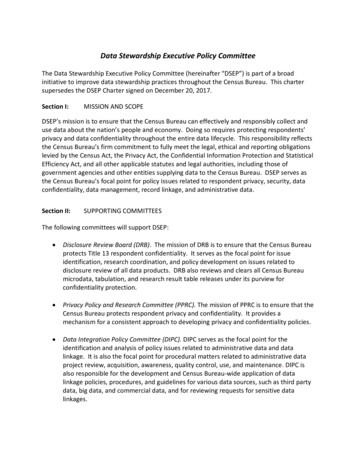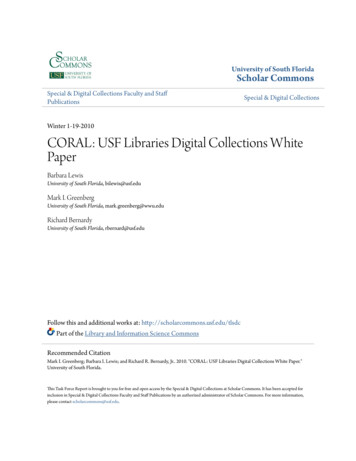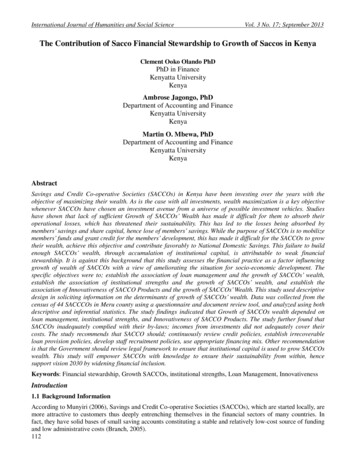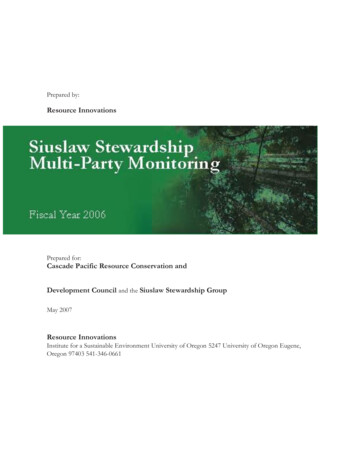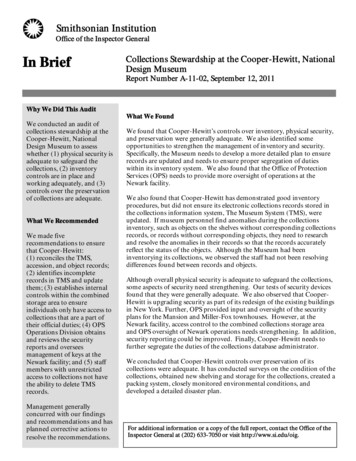
Transcription
Smithsonian InstitutionOffice of the Inspector GeneralIn BriefCollections Stewardship at the Cooper-Hewitt, NationalDesign MuseumReport Number A-11-02, September 12, 2011 Why We Did This AuditWe conducted an audit ofcollections stewardship at theCooper-Hewitt, NationalDesign Museum to assesswhether (1) physical security isadequate to safeguard thecollections, (2) inventorycontrols are in place andworking adequately, and (3)controls over the preservationof collections are adequate.What We RecommendedWe made fiverecommendations to ensurethat Cooper-Hewitt:(1) reconciles the TMS,accession, and object records;(2) identifies incompleterecords in TMS and updatethem; (3) establishes internalcontrols within the combinedstorage area to ensureindividuals only have access tocollections that are a part oftheir official duties; (4) OPSOperations Division obtainsand reviews the securityreports and overseesmanagement of keys at theNewark facility; and (5) staffmembers with unrestrictedaccess to collections not havethe ability to delete TMSrecords.Management generallyconcurred with our findingsand recommendations and hasplanned corrective actions toresolve the recommendations.What We FoundWe found that Cooper-Hewitt’s controls over inventory, physical security,and preservation were generally adequate. We also identified someopportunities to strengthen the management of inventory and security.Specifically, the Museum needs to develop a more detailed plan to ensurerecords are updated and needs to ensure proper segregation of dutieswithin its inventory system. We also found that the Office of ProtectionServices (OPS) needs to provide more oversight of operations at theNewark facility.We also found that Cooper-Hewitt has demonstrated good inventoryprocedures, but did not ensure its electronic collections records stored inthe collections information system, The Museum System (TMS), wereupdated. If museum personnel find anomalies during the collectionsinventory, such as objects on the shelves without corresponding collectionsrecords, or records without corresponding objects, they need to researchand resolve the anomalies in their records so that the records accuratelyreflect the status of the objects. Although the Museum had beeninventorying its collections, we observed the staff had not been resolvingdifferences found between records and objects.Although overall physical security is adequate to safeguard the collections,some aspects of security need strengthening. Our tests of security devicesfound that they were generally adequate. We also observed that CooperHewitt is upgrading security as part of its redesign of the existing buildingsin New York. Further, OPS provided input and oversight of the securityplans for the Mansion and Miller-Fox townhouses. However, at theNewark facility, access control to the combined collections storage areaand OPS oversight of Newark operations needs strengthening. In addition,security reporting could be improved. Finally, Cooper-Hewitt needs tofurther segregate the duties of the collections database administrator.We concluded that Cooper-Hewitt controls over preservation of itscollections were adequate. It has conducted surveys on the condition of thecollections, obtained new shelving and storage for the collections, created apacking system, closely monitored environmental conditions, anddeveloped a detailed disaster plan.For additional information or a copy of the full report, contact the Office of theInspector General at (202) 633-7050 or visit http://www.si.edu/oig.
Smithsonian InstitutionOffice of the Inspector GeneralDateToccFromSubjectSeptember 12,2011Bill Moggridge, Director, Cooper-Hewitt, National Design MuseumWilliam Lynch, Director, Office of Protection ServicesRichard Kurin, Under Secretary for History, Art, and CultureScott Miller, Deputy Under Secretary for Collections and Interdisciplinary SupportWilliam G. Tompkins, National Collections Coordinator, National Collections ProgramBruce Kendall, Director, Office of Facilities Engineering and OperationsCaroline Baumann, Deputy Director, Cooper-Hewitt, National Design MuseumlS} n, Inspector GeneralAudit of Collections Stewardship at the Cooper-Hewitt, National Design Museum,Number A-11-02This report presents the results of our audit of collections stewardship at the Cooper Hewitt, National Design Museum (Cooper-Hewitt). It is one in our series of auditscovering collections at the Smithsonian. The Office of the Inspector General (OIG)initiated this audit to examine collections management, which is essential forsafeguarding the collections for public and scholarly use and for reducing the risk oflossor theft. Earlier audits covered the National Museum of Natural History (NMNH) (A 05-06, September 29, 2006), the National Air and Space Museum (NASM) (A-09-04,March 17,2010), and the National Museum of American History (NMAH) (A-10-03-1,February 8, 201l).Collections are at the core of the Smithsonian. The Smithsonian Strategic Plan for fiscalyears 2010-2015 states:The collections are fundamental to our work and to that of countlessscholars and many federal agencies; it is our responsibility to preservethem for future generations. To ensure they remain available, we willimprove collections storage and management, substantially expandaccess to collections through digital technologies, and buildpublic/private partnerships that strategically enhance collections care.Based on the common patterns in our prior reports addressing collections care, security,and management, the Institution's Board of Regents has expressed concern that theSmithsonian has not put enough focus on protecting its collections. As a result, theSecretary tasked the Deputy Under Secretary for Collections and InterdisciplinarySupport to catalogue the collections challenges facing the museums along with theremedial actions undertaken to date and planned. The Deputy Secretary will report to theBoard of Regents on the results at future meetings of the Audit and Review Committee.MRC 524PO Box 37012Washington DC 20013·0712202.633.7050 Telephone202.633.7079 Fax
Our objectives in the audit were to assess whether (1) physical security is adequate tosafeguard the collections, (2) inventory controls are in place and working adequately, and(3) controls over the preservation of collections are adequate. We describe in detail ouraudit scope and methodology in Appendix A.RESULTS IN BRIEFOur prior audit reports on NMNH, NASM, and NMAH found serious weaknesses ininventory and security controls. Although we identified areas where Cooper-Hewittcould make some improvements, we found that Cooper-Hewitt’s controls over inventory,physical security, and preservation were generally adequate. We also identified someopportunities to strengthen the management of inventory and security. Specifically, theMuseum needs to develop a plan to ensure records are updated and needs to ensureproper segregation of duties within its inventory system. We also found that the Office ofProtection Services (OPS) needs to provide more oversight of operations at the Newarkfacility.Cooper-Hewitt invested considerable time and resources developing inventory controlsby conducting a comprehensive inventory of its entire collection; however, electronicrecords are incomplete and require reconciliation. If museum personnel found anomaliesduring their collections inventory, such as objects on the shelves without correspondingcollections records, or records without corresponding objects, they assigned objects atemporary tracking number to continue the inventory with the intent to go back andreconcile the information in the future. Although reconciliation cannot be accomplisheduntil the collections move to permanent storage, Cooper-Hewitt needs to develop a planto ensure the information is updated in a timely manner.Although overall physical security is adequate to safeguard the collections, some aspectsof security need strengthening. Our tests of security devices found that they weregenerally adequate. We also observed that Cooper-Hewitt is upgrading security as part ofits redesign of the existing buildings in New York. Further, OPS provided input andoversight of the security plans for the Mansion and Miller-Fox townhouses. However, atthe Newark facility, access control to the combined collections storage area and OPSoversight of Newark operations need strengthening. In addition, security reporting couldbe improved. Finally, Cooper-Hewitt needs to further segregate the duties of thecollections database administrator.We concluded that Cooper-Hewitt’s controls over preservation of its collections wereadequate. The Museum has conducted surveys on the condition of the collections,obtained new shelving and storage for the collections, created a storage system, closelymonitored environmental conditions, and developed detailed disaster plans. Although itcannot address all collections preservation issues, overall the Museum is making good useof limited resources.We recommended that Cooper-Hewitt strengthen physical controls over access at theCooper-Hewitt’s Newark facility by controlling access to combined collections storageareas and ensuring that OPS obtains and reviews security reports and oversees keymanagement. Further, we recommended that Cooper-Hewitt prevent staff members fromhaving unrestricted access to both collection objects and collections records. We alsorecommended that it improve inventory controls for its collections by reconciling2
electronic collections records to its accession and object records, and by identifying andupdating incomplete collections records. Given the Museum’s adequate controls overcollections preservation, we did not make recommendations in this area.BACKGROUNDThe Cooper-Hewitt, National Design MuseumThe Museum was founded in 1897 by Amy, Eleanor, and Sarah Hewitt, granddaughters ofindustrialist Peter Cooper, as part of The Cooper Union for the Advancement of Scienceand Art. Cooper-Hewitt has operated as a branch of the Smithsonian since 1967. In 1976Cooper-Hewitt opened in the former home (mansion) of industrial magnate AndrewCarnegie on Fifth Avenue in New York City.Cooper-Hewitt is devoted to historic and contemporary design. The Museum presentsperspectives on the impact of design on daily life through active educational andcuratorial programming. The Museum collections include approximately 226,817 design1objects and a design library. Its exhibitions, educational programs, and on-site master'sprogram explore the process of design, both historic and contemporary.The Museum is currently redesigning the mansion’s interior to increase exhibition space.This reconstruction project closed the mansion for approximately two years, beginning inmid-2011. The mansion’s campus also includes two historic townhouses, the Miller andFox buildings (Miller-Fox). Cooper-Hewitt plans to reopen Miller-Fox after completionof a major reconstruction in late 2011 with a new library facility to include lecture roomsas well as curatorial and administrative offices.The Museum has also leased long-term storage space in Newark, New Jersey to house thebulk of its permanent collection as well as provide the Museum with additional registrarworkspace, collections study, photography, and conservation lab space. At the time ofour audit, most of Cooper-Hewitt’s collections were placed in temporary storage awaitingthe completion of renovations to the permanent storage space. In preparation for therenovations and the move of the collections to new storage space, Cooper-Hewittrecognized the need for a comprehensive inventory of their entire collection.At Cooper-Hewitt, care and accountability for the collections is the responsibility of theCuratorial Director and the Director’s staff. Among other duties, the Director isresponsible for overseeing the Registrar’s Office, the Conservation Office, and fourCuratorial Departments: Drawings, Prints, and Graphic Design; Product Design andDecorative Arts; Textiles; and Wallcoverings. The Registrar’s Office is responsible for thelegal documentation of accessioned objects and the movement of loaned objects (bothincoming and outgoing loans) and has access to all collections. The Registrar staffmaintains a degree of independence from the curatorial staff, since they set the collectionsmanagement policy and ensure that it is being followed. The Conservation Office isresponsible for the preservation of all collections, which includes determining the1This number does not include those objects managed by the Cooper-Hewitt Library, as they were excludedfrom our scope.3
appropriate standards for the collections’ storage environment, housing, material andtechniques. Curators are responsible for the physical care of collections, which involvesbalancing collections care with access to the collections.Cooper-Hewitt’s Collecting DivisionsThe collections encompass the holdings of the Museum’s four curatorial departments:Drawings, Print, and Graphic Design; Product Design and Decorative Arts; Textiles; andWallcoverings.Drawings, Prints, and Graphic Design (DPGD)The Drawings, Prints, and Graphic Design collection ishome to approximately 160,000 works of art dating fromthe Renaissance to the present related to the history ofEuropean and American art and design. The collectionincludes designs for architecture, decorative arts,gardens, interiors, ornament, jewelry, theater, textiles,graphic and industrial design, as well as the fine arts.Van Gogh, Cooper-Hewitt,National Design MuseumProduct Design and Decorative Arts (PDDA)Cooper-Hewitt’s department of Product Design andDecorative Arts is home to approximately 40,000stobjects dating from antiquity to the 21 century,which form a resource for decorative art and design.International in scope, the collection contains adiverse assortment of objects, reflecting a vast rangeof historical styles and design movements. Categoriesof objects within the collections include Ceramics,Furniture, Metalwork, Lighting, Glass, Jewelry,Architectural Elements, and Industrial Design.4Silver Charger, Adolf Gaap, CooperHewitt, National Design Museum
TextilesThe Textiles collection contains more than 30,000 piecesrepresenting a wide range of woven and non-woventechniques. Extending from ancient to contemporaryexamples, the earliest pieces in the collection are fromHan Dynasty China (206 BC-AD 221).Embroidery and Stitching Panel,Early 17th Century, CooperHewitt, National Design MuseumWallcoveringsCooper-Hewitt’s Wallcoverings departmentcontains a large and varied collection ofwallpaper, with more than 10,000 pieces fromthe 17th century through today and representsmany countries of origin. The collectionincludes individual wallpaper pieces, rolls,sample books, advertisements, and printingtools that have been collected for their historicassociations, as design inspiration, or asexamples of printed material.Winnie the Pooh, Wallcoverings, CooperHewitt, National Design MuseumCooper-Hewitt SecurityOPS is responsible for the security of staff, visitors, and collections Institution-wide. OPSis a branch of the Office of Facilities Engineering and Operations (OFEO). OPS providesprotection and security services at Smithsonian facilities on and near the National Mall inWashington, D.C., New York City, and Panama. Each building or compound has aSecurity Manager who is in charge of overseeing security for that location. The SecurityManager reports to the Area Security Manager, who is responsible for overseeing multiplefacilities in a geographic area. The Technical Security Division (TSD) of OPS providestechnical assistance and advisory services to SI bureaus, offices, and facilities, as well asmaintains and repairs all technical security equipment, such as door access-card readers,cameras, and motion detectors, throughout the Institution. TSD also provides securitydesign and construction support.Smithsonian Collections Management Policy and Implementation ManualSmithsonian Directive (SD) 600, Collection Management Policy, states that effectivecollections management requires a continuous inventory system to support decisionsregarding collections use, growth, storage, and security. Full inventory control requirescreating and maintaining reliable information about the identification, location, andaccessibility of collection items. Inventory is a critical component of ongoing collectionsdocumentation.5
The SD 600 Implementation Manual requires that a collecting unit accurately andcomprehensively document its collections. It also requires collecting units to create andmaintain accurate and current inventory records that will identify, locate, and give anaccount of each object’s condition to ensure maximum accessibility consistent with itssecurity. The manual states that collecting units must clearly establish lines of authorityand responsibility for all collections activities and must emphasize the maintenance ofcomplete, written records regarding all collections-related decisions and activities.Accordingly, SD 600 and the Implementation Manual require each unit to implement acontinuous inventory system for (1) conducting, supervising, and approving cyclicalinventories and reconciliation of collection records; (2) implementing a written cyclicalinventory plan that is reviewed by all individuals who will conduct the inventory andapproved by the Museum director; and (3) ensuring separation of duties andimplementation of other internal controls to prevent the unauthorized removal ofcollection objects.Cooper-Hewitt Collections Management Policy (CMP)According to Cooper-Hewitt’s CMP, the Registrar’s Office is responsible for maintainingand making available up-to-date records that document the history and all activitiesaffecting objects in Cooper-Hewitt’s custody, along with their status. The Registrar’sOffice is responsible for creating and maintaining records for each object and maintainingincoming and outgoing loan records; the appropriate curatorial department is responsiblefor cataloguing each object and maintaining objects research files; and the conservationdepartment is responsible for keeping accurate records of condition and treatment. Allrecords must be created in an accurate, complete, and timely manner and updatedregularly.Cooper-Hewitt Collections Management Software – The Museum System (TMS)Cooper-Hewitt has implemented The Museum System (TMS) as their collectionsinformation system. The Museum is one of the many Smithsonian art museums that haveimplemented TMS and is on the Art Collections Information System committee (ArtCIS).The ArtCIS facilitates collaboration between units and encourages the sharing ofinformation, best practices and solutions to problems, and standardization of proceduresand terminology.RESULTS OF AUDITWe found that Cooper-Hewitt’s controls over inventory, physical security, andpreservation were generally adequate. We did identify some opportunities to strengthenthe management of inventory and security. Specifically, the Museum needs to develop aplan to ensure records are updated and effect proper segregation of duties within itsinventory system. We also found that OPS needs to provide more oversight of operationsat the Newark facility.6
Inventory Controls are Adequate but Could be ImprovedBackgroundBeginning in 2007, in anticipation of closing for its redesign, Cooper-Hewitt began a 100percent inventory of its collections. Museum staff went shelf by shelf and verified eachobject’s information in TMS. They found some objects that were neither properly labelednor adequately documented in TMS. In these instances, Museum staff assigned atemporary tracking number to the object so they could complete the inventory in time forthe move, with the intent to go back at a later date to research the objects further andreconcile the information. Reconciling the information in TMS requires the staff toidentify accession documentation associated with the object and then verify whether theMuseum had assigned the object an accession number. To date, the Museum hasinventoried PDDA, Textiles, and Wallcoverings and is currently inventorying DPGD.As a part of the inventory, Cooper-Hewitt documentedstorage, condition, and conservation issues of thecollections. With the move of the collectionsimminent, the Museum packed the objects to preparethem for transport to temporary storage. Once objectshad been inventoried, the boxes were marked toindicate key information, such as whether theinventory was completed, the pertinent department,and where they were going to be stored.Inventory Labeling System usedfor the Collection MoveTesting ResultsTo test the accuracy of the inventory records and to confirm whether objects could belocated, we selected a sample of objects from each of the four curatorial departments. Intotal, we sampled 369 objects at the Museum and at offsite storage locations. Our results,summarized in Appendix C, show that we were able to locate 352, or 95 percent, of thesample. We could not locate 16, or 4 percent, of the sample. The objects we could notlocate were not considered priority collection objects; they consisted of various types ofprints such as drawings, a greeting card, and a lithograph. We found that one object hadbeen deaccessioned from the Museum’s collection, and Museum personnel updated theinventory records based on our audit work.In addition to our sample from all four departments, we also attempted to review 100%of the objects that the Museum had identified as priority - those objects of the greatestsignificance to the collection in terms of their importance and uniqueness to the historyof design, cultural significance, and the Smithsonian’s mission. The Museum’s DPGDpriority objects include the drawing Sand Barges Moored at the Quay by Vincent VanGogh and a rare drawing by Michelangelo. The Textiles department’s priority objects7
include a bonnet and mittens dating back to the year 300 BC. PDDA priority objectsinclude vases and a lamp by Louis Comfort Tiffany as well as many silver-gilt pieces. TheWallcoverings priority objects include various 19th century French floral compositionsand scenic wallpapers, such as Views of Italy and El Dorado. Since many of these objectswere packed for temporary storage, we could not view them all. We verified all of theaccessible priority objects except for one piece of an object that was identified as missingby Cooper-Hewitt prior to our audit. Cooper-Hewitt staff believes this was arecordkeeping error but we could not confirm their belief.Inventory Records are IncompleteDespite the Museum having conducted a comprehensive inventory of its collections, TMSrecords are incomplete and require reconciliation.We found that in many cases a portionof TMS collection records did notcontain identifying information suchas description. In our analysis of the226,817 records (Appendix C, table 2),we found that approximately 73percent, or 166,648 records, had blank“Description” fields. Of these records75 percent were for objects in theDrawings, Prints, and Graphic DesignDivision and 13 percent were fromProduct Design and Decorative Arts.Ten percent were from Textiles and 2percent were from Wallcoverings.Blank Description Field by tt staff assigned a temporary tracking number to many objects theydiscovered during the inventory but that they could not verify in TMS at the time. TheMuseum assigned 11,315 objects temporary tracking numbers based on the most recentinventory (Appendix C, table 3). Once the move of the collections is complete, staff willneed to research accession records and reconcile the objects’ information in TMS.Performing reconciliations of the TMS data, accession records, and the object is part ofthe inventory process and an essential step for ensuring the accuracy of all the Museum’scollections records. Cooper-Hewitt’s records are incomplete because the Museum hasnot converted all of its paper records into TMS, and reconciliation of the inventorycannot be performed until the move of its collections to permanent storage. However,Cooper-Hewitt staff expressed concern that because they have limited resources, theywould not be able to properly reconcile the inventory data after the collection was movedto permanent storage. The Museum’s lack of a dedicated Collections Manager in three ofthe four collecting departments compounds this issue.Incomplete TMS collections data leaves collections objects vulnerable to loss or theft,diminishes accountability, and reduces the scholarly value of the objects. It also adverselyaffects Cooper-Hewitt’s ability to fulfill the mission of the Smithsonian by not having theobjects accessible for exhibit, research, and public programming purposes.8
Incomplete recordkeeping creates the appearance that objects are missing when in fact theobjects may have actually been deaccessioned or assigned a temporary tracking number.The temporary tracking numbers create the potential for duplicate records as does theassignment of accession numbers to missing objects. Such practices also reduce theusefulness of records to inventory the collections and increase the risk that objects couldbe lost or stolen without detection.At the time of our audit, Cooper-Hewitt categorized 10,428, or 5 percent, of its objects asmissing in TMS. Management believes that a portion of these missing objects are archivesand study materials, not accessioned objects. Cooper-Hewitt staff believes that the 11,315objects assigned temporary tracking numbers are in fact the objects labeled as missing inthe system. We could not verify their assertion without Cooper-Hewitt performing areconciliation.Our inventory testing produced similar results (Appendix C, table 1); out of the 369objects we tested, 16, or 4 percent, of the objects could not be found. We believe this rateis reasonable based on our audit sample. However, we believe that Cooper-Hewitt shouldstrive for 100 percent accountability for its collections. Of the 16 objects we could notlocate during the testing, Cooper-Hewitt provided additional information indicating thatthe objects may not actually be missing, but that instead their recordkeeping wasinaccurate. The recordkeeping errors may be the result of a lack of reconciliation frompast inventories, the conversion of the collections data to TMS in 1998, or temporarytracking numbers.Recommendations:We recommend that the Director of Cooper-Hewitt, develop a plan to:1. Reconcile the TMS, accession, and object records.2. Identify incomplete records in TMS and update them.Physical Security to Safeguard the Collections is Adequate but Could be ImprovedBackgroundSecurity of the collections is the responsibility of both the Museum and OPS. OPS isorganized into separate divisions. The Operations Division is generally responsible forday-to-day operations and emergency situations. The TSD provides security design andconstruction support for all Smithsonian facilities.NewarkSince the New York facilities were in transition, we focused our testing of security devicesat the Newark facility. Based on our testing, we found the physical security at the Newarkfacility was generally adequate to safeguard the collections; however, we found weaknessesin the design of some security procedures. Collections were not at risk in the spacebecause, at the time of our testing, they had not been moved into the permanent storagespace. The weaknesses we identified involved two controls in particular: access within thecombined storage area, and oversight by OPS’ Operations Division. We also have9
concerns regarding the reporting of security activity in Newark. Some of the securitydevices failed our testing. OPS TSD is actively addressing those devices.Combined Collections Storage SpaceAlthough the Museum has planned well for its overall physical security to safeguardcollections, at the time of our audit, some internal controls were not planned for withinthe Newark collections storage space. The current plans are to co-locate approximately 70percent of the collections from all four departments in one space. Four separate groups ofpeople representing each collecting department oversee the collections. Based on theconfiguration of the space, once a person enters the space, he or she has immediate accessto all collections areas regardless of need.The SD 600 Collections Management Policy requires each collecting unit to establishauthority and assign responsibility to control, monitor, document, and providecollections and collections information access; incorporate applicable guidelines foraccess set forth in the SD 600 Implementation Manual; and establish policies, criteria, andprocedures for permitting responsible access to physical collections and collectionsinformation. The SD 600 Collections Management Implementation Manual further statesthat stewardship involves policy and planning documents that address the needs ofexisting collections and future collecting activities. This manual also requires collectingunits to secure all collections in controlled areas where access is monitored anddocumented.The Draft Smithsonian’s Collection Space Security Standards state that access to collectionsspace should be limited to the minimum number of staff whose official duties requirefrequent and regular access. Collections management staff should consider separatingcollections spaces by department or access requirements. These standards optimize theavailable space to reduce unnecessary access to the space.Prior to the move to Newark, the Museum stored each of its collections in separatestorage spaces that limited access to only those personnel assigned to work on thecollections. That the new collection storage space at Newark consists of one space for allfour departmental collections introduces a new risk: individuals granted access to thisspace also have access to collections beyond their official dutie
The Museum System (TMS), were updated. If museum personnel find anomalies during the collections inventory, such as objects on the shelves without corresponding collections records, or records without corresponding objects, they need to research and resolve the anomalies in their records so that the records accurately

